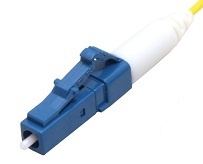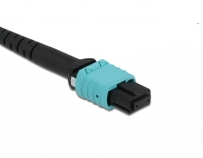Description:
This article contains general information regarding fiber as well as specific information regarding zu LANCOM transceiver modules.
Advantages and Disadvantages for fiber compared to regular Ethernet:
| Advantages fiber | Disadvantages fiber |
|---|---|
| High range | Higher costs |
| High bandwith | PoE not possible |
| No influence through electromagnetic fields possible | Relatively high effort necessary (cable splicing, connector, limited bending radius) |
| No crosstalk to other lines | |
| No short circuit possible |
Comparison Singlemode vs. Multimode:
| Singlemode | Multimode |
|---|---|
Very high range up to 40 kilometers and more, therefore especially suited for
| Medium range from several hundred meters to a few kilometers, therefore especially suited for
|
| Much higher costs for transceivers compared to Multimode | Significantly lower costs for transceivers compared to Singlemode |
Connector types used by LANCOM transceiver modules:
| Description | |
|---|---|
LC connector: (Lucent Connector or also Local Connector) The LC connector was developed by Lucent Technologies. Due to the compactness (Small Form Factor) it features a high port density and is therefure used in switches quite often. LC connectors are available in two common formats:
Important: LC-PC / LC-UPC and LC-APC must not be connected to each other, as it is very likely that the LC-APC connector would be damaged! | |
MPO/MTP connector: (Multipath Push-On and also Multiple-Fibre Push-On) / (Mechanical Transfer Push-On) The MPO connector was originally developed by NTT and further developed to MTP by the joint venture USA-Conec.
|
Comparison of Singlemode cable types:
| OS1 | OS2 |
|---|---|
| Indoor applications | Outdoor applications |
| Maximum range of 10 km | Maximum range of 200 km |
| Lower possible stretch compared to OS2 | Higher stretch possible compared to OS1 |
Range for the different cable types:
| Transfer rates | Cable types | |||||
|---|---|---|---|---|---|---|
| Multimode | Singlemode | |||||
| OM1 | OM2 | OM3 | OM4 | OM5 | OS1 / OS2 | |
| 1 GBit/Sec. | 550 m | 550 m | 550 m | 1000 m | 1000 m | 5 km (1000Base-LX) |
| 10 GBit/Sec. | 30 m | 80 m | 300 m | 550 m | 550 m | 10 km (10GBase-LR), max. 40 km (10GBase-ER) |
| 25 GBit/Sec. | 70 m | 100 m | 440 m | 10 km (25GBase-SR), max. 40 km (25GBase-ER) | ||
| 40 GBit/Sec. | 100 m | 125 m | 150 m | 10 km (40GBase-SR), max. 40 km (40GBase-ER) | ||
| 100 GBit/Sec. | 70 m | 100 m | 150 m | 10 km (100GBase-SR), max. 40 km (100GBase-ER) | ||
The cable types are color coded as shown in the table to make them easier to identify. In this table the colors are presented as good as possible, but there can be slight deviations to the actual colors.
OM4 cable is colored violet (ericaviolet) only in europe and parts of the USA, otherwise these cables are colored light blue (aqua) like OM3 cable.
Necessary number of fiber strands and cable recommendation for LANCOM Multimode transceiver modules:
| LANCOM transceiver module | Module type | Singlemode / Multimode | Max. transfer rate | Max. range | Connector type | Necessary strand number | Recommended cable type | Notes |
|---|---|---|---|---|---|---|---|---|
| LANCOM SFP-SX-LC1 | 1000Base-SX | Multimode | 1 Gbit/Sec. | 550 m | LC | 2 strands | as of OM1 | |
| LANCOM SFP-SX2-LC1 | 1000Base-SX | Multimode | 1 Gbit/Sec. | 2000 m | LC | 2 strands | as of OM2 | 2 km only possible with mode conditioning cable, otherwise max. 1 km. |
| LANCOM SFP-LX-LC1 | 1000Base-LX | Singlemode | 1 Gbit/Sec. | 10 km | LC | 2 strands | OS1 / OS2 depending on the scenario | |
| LANCOM SFP-BiDi1310-LC10 | 10GBase-BX | Singlemode | 10 Gbit/Sek. | 20 km | LC/PC | 1 Faser | OS1 / OS2 je nach Szenario | Bidirectional module with 1270 und 1330 nm wavelength. |
| LANCOM FP-BiDi1550-SC1 | 1000Base-BX | Singlemode | 1 Gbit/Sec | 20 km | SC/UPC | 1 strand | OS1 / OS2 depending on the scenario | Bidirectional module with 1310 and 1550 nm wavelength. |
| LANCOM SFP-SX-LC10 | 10GBase-SR/SW | Multimode | 10 Gbit/Sec. | 300 m | LC | 2 strands | as of OM3 | |
| LANCOM SFP-LX-LC10 | 10GBase-LR/LW | Singlemode | 10 Gbit/Sec. | 10 km | LC | 2 strands | OS1 / OS2 depending on the scenario | |
| LANCOM SFP-LR40-LC10 | 10GBase-ER | Singlemode | 10 Gbit/Sec. | 40 km | LC | 2 strands | OS2 | |
| LANCOM SFP-SR-LC25 | 25GBase-SR/SW | Multimode | 25 Gbit/Sec. | 300 m | LC | 2 strands | OM5 | |
| LANCOM SFP-LR-LC25 | 25GBase-LR/LW | Singlemode | 25 Gbit/Sec. | 10 km | LC | 2 strands | OS1 / OS2 depending on the scenario | |
| LANCOM SFP-SR-MPO40 | 40GBase-SR/SW | Multimode | 40 Gbit/Sec. | 300 m | MPO | 8 strands | OM5 | The middle 8 of 12 fiber strands are used. It is also possible to use a cable with 12 or 16 fiber strands. In this case the remaining 4 or 8 fiber strands would lie idle. |
| LANCOM SFP-LR-LC40 | 40GBase-LR/LW | Singlemode | 40 Gbit/Sec. | 10 km | LC | 2 strands | OS1 / OS2 depending on the scenario |
Glossary:
- SFP: Small Formfactor Pluggable, supports 1 GBit/Sec.
- SFP+: Extended version of SFP, supports 10 GBit/Sec.
- SFP28: Extended version of SFP+, supports 25 GBit/Sec.
- QSFP+: Quad Small Formfactor Pluggable, supports 40 GBit/Sec. (4 x SFP+)
- SR: Short Reach Modul, usually ranges of a few hundred meters (e.g. 10GBase-SR)
- LR: Long Reach Modul, ranges of a few kilometers (e.g. 10GBase-LR)
- ER: Extended Reach Modul, ranges up to 40 kilometers (e.g. 10GBase-ER)
- OM: Optical Multimode
- OS: Optical Singlemode

